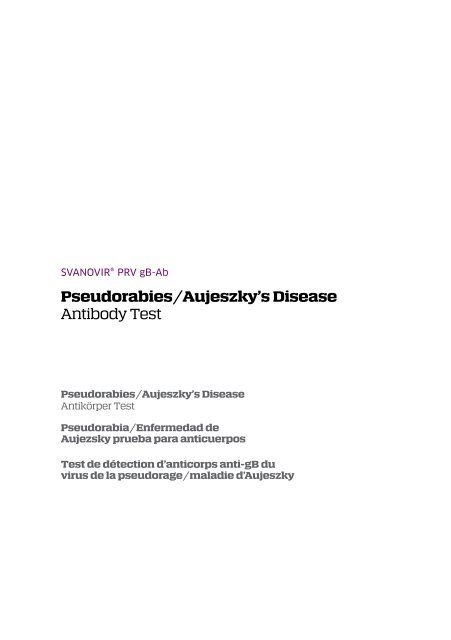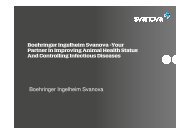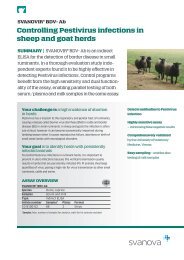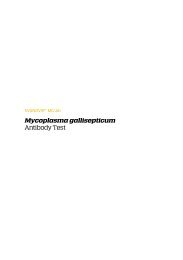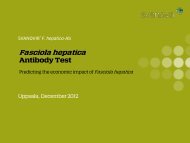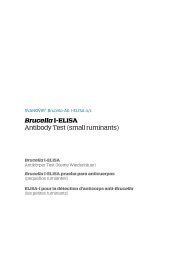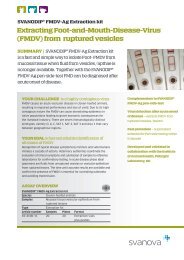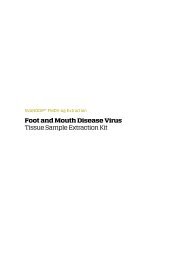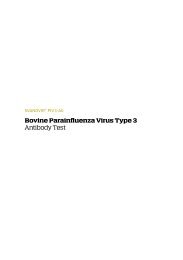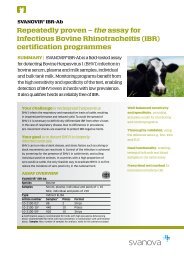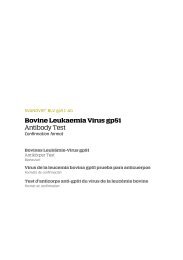Pseudorabies/Aujeszky's Disease Antibody Test - Svanova Biotech AB
Pseudorabies/Aujeszky's Disease Antibody Test - Svanova Biotech AB
Pseudorabies/Aujeszky's Disease Antibody Test - Svanova Biotech AB
You also want an ePaper? Increase the reach of your titles
YUMPU automatically turns print PDFs into web optimized ePapers that Google loves.
SVANOVIR® PRV gB-Ab<br />
<strong>Pseudorabies</strong>/Aujeszky’s <strong>Disease</strong><br />
<strong>Antibody</strong> <strong>Test</strong><br />
<strong>Pseudorabies</strong>/Aujeszky’s <strong>Disease</strong><br />
Antikörper <strong>Test</strong><br />
Pseudorabia/Enfermedad de<br />
Aujezsky prueba para anticuerpos<br />
<strong>Test</strong> de détection d’anticorps anti-gB du<br />
virus de la pseudorage/maladie d’Aujeszky
Contents<br />
Art. No.<br />
10-7262-02<br />
Art. No.<br />
10-7262-10<br />
Microtitre plate<br />
Microtitre plates (96 wells) with noninfectious<br />
PRV antigen (sealed and stored<br />
dry)<br />
Conjugate<br />
Ready-to-use (horseradish peroxidase<br />
conjugated anti-PRV gB monoclonal<br />
antibodies)<br />
PBS-Tween Solution<br />
20 x concentrate<br />
2<br />
(Strips)<br />
12 x 8<br />
10<br />
(Plates)<br />
1 x 24 mL 1 x 120 mL<br />
1 x 125 mL 3 x 125 mL<br />
Sample Dilution Buffer 1 x 8 mL 1 x 40 mL<br />
Substrate Solution<br />
(Tetramethylbenzidine in substrate buffer<br />
containing H 2<br />
O 2<br />
) - STORE IN THE DARK!<br />
Stop Solution<br />
Contains sulphuric acid (2M) - CORROSIVE!<br />
A. Positive Control Serum<br />
- Contains preservatives<br />
B. Negative Control Serum<br />
- Contains preservatives<br />
1 x 20 mL 1 x 100 mL<br />
1 x 10 mL 1 x 50 mL<br />
1 x 2.5 mL 1 x 4.5 mL<br />
1 x 2.5 mL 1 x 4.5 mL<br />
This manual covers the following<br />
SVANOVIR® PRV gB-Ab ELISA kits:<br />
Article number 10-7262-02 and<br />
10-7262-10<br />
<br />
SVANOVIR® PRV gB-Ab
SVANOVIR® PRV gB-Ab<br />
<strong>Pseudorabies</strong>/Aujeszky’s <strong>Disease</strong><br />
<strong>Antibody</strong> <strong>Test</strong><br />
Name and Application<br />
SVANOVIR® PRV gB-Ab is an Enzyme Linked<br />
Immunosorbent Assay (ELISA) for the<br />
detection of PRV gB antibodies in porcine<br />
serum and plasma samples.<br />
General information<br />
<strong>Pseudorabies</strong> Virus (PRV) or suid<br />
herpesvirus 1 , first isolated by Aujeszky<br />
(1902) from an ox with signs of rabies, has<br />
the pig as the primary host, while cattle and<br />
some other animal species are secondary<br />
hosts with infected pigs as the initial<br />
source of infection. In countries with a high<br />
prevalence of endemic pseudorabies, this<br />
disease, being often, particularly in piglets,<br />
fatal, causes severe losses annually 1 . In<br />
piglets, but also in older pigs, neurological<br />
disorders are intermingled with symptoms<br />
from the respiratory tract. The disease is<br />
less pronounced in older pigs and, after<br />
recovery, i.e. in adult pigs, a latent infection<br />
persists lifelong. From such asymptomatic<br />
pigs, PRV has been isolated from trigeminal<br />
ganglia and tonsils 2 . Virus transmission<br />
occurs mainly through nasal secretions by<br />
contact or even by the aerogenic route 1 .<br />
The infection of pregnant sows may reach<br />
via the placenta the fetuses and cause<br />
abortion, mummification or stillbirth.<br />
All infected herds in endemic regions<br />
should be monitored for the presence of<br />
infection and uninfected herds protected by<br />
control measures. Some countries practice<br />
vaccination, while some others try to<br />
control the spread by culling seropositive<br />
pigs or by combination of both measures.<br />
SVANOVIR® PRV gB-Ab<br />
Differentiation of vaccinated from infected<br />
pigs<br />
If both control measures, i.e. vaccination<br />
and eradication by culling seropositive<br />
pigs are (or are to be) introduced, a<br />
differentiation of vaccinated pigs from<br />
those infected must be introduced, as<br />
both infected and vaccinated pigs are<br />
seropositive. Most vaccinal strains used<br />
are well-known attenuated strains with a<br />
deletion in their genome (DNA) of the gene<br />
sequence coding for the virulence factor,<br />
the glycoprotein E, (gE/gI) 2 . Consequently,<br />
vaccinated pigs lack antibodies against<br />
the gE antigen. The differentiation is thus<br />
based on the presence of antibodies to gE<br />
in infected pigs but the absence of these<br />
antibodies in vaccinated pigs 3 .<br />
Since both the vaccinal and field strains of<br />
PRV possess another glycoprotein, gB (gII),<br />
antibodies to gB are present in sera of both<br />
infected and vaccinated pigs but absent in<br />
sera of non-infected and non-vaccinated<br />
pigs 4 . The SVANOVIR® PRV gE and gB ELISA<br />
systems are based on these premises.<br />
Principle<br />
The kit procedure is based on the blocking<br />
ELISA. In this procedure the gB-test,<br />
microtitre plates are coated with PRV<br />
antigen. This antigen is derived from<br />
an inactivated PRV strain, known to<br />
posses the glycoprotein gB (as well as<br />
gE). The indicator used for the detection<br />
of presence or absence of antibodies<br />
against gB is a monoclonal antibody (mAb)<br />
specifically directed against gB. The mAb<br />
are conjugated with the enzyme horseradish<br />
peroxidase (HRP). If antibodies are<br />
absent in the test serum, i.e. from non<br />
-infected or non-vaccinated pigs, the gB<br />
antigen will remain free and the conjugated<br />
mAb subsequently added will bind. The<br />
enzyme present (HRP) will catalyze the<br />
added substrate, which results in a colour<br />
reaction. If, on the other hand, antibodies<br />
against gB are present in the serum, i.e.
from infected and/or vaccinated pigs, these<br />
antibodies will bind to the gB antigen in<br />
the well. This will block the possibility of<br />
the conjugated mAb subsequently added<br />
to react with the gB antigen. The unbound<br />
conjugated mAb will be removed by the<br />
washing procedure followed, resulting in<br />
no colour reaction when the substrate is<br />
added.<br />
To discriminate between animals infected<br />
and animals vaccinated with a gE- delted<br />
vaccine, it is recommended to use the<br />
SVANOVIR® PRV gE-Ab test.<br />
Materials needed but not provided<br />
1. Precision pipettes<br />
2. Disposable pipette tips<br />
3. Distilled, deionised or any similar high<br />
quality water<br />
4. Wash bottle, multichannel pipettor or<br />
plate washer<br />
5. Container: 1 to 2 litres for PBS-Tween<br />
6. Microplate photometer, 450 nm filter<br />
Specimen information<br />
100 µL of blood serum or plasma is required<br />
for each sample well. Fresh, refrigerated or<br />
previously frozen serum or plasma may be<br />
tested.<br />
Preparation of reagents<br />
PBS-Tween Buffer:<br />
Dilute the PBS-Tween Solution 20 x<br />
concentrate 1/20 in distilled water. Prepare<br />
500 mL per plate by adding 25 ml PBS-<br />
Tween solution to 475 mL distilled water<br />
and mix thoroughly.<br />
N.B. Please check that there is no crystal<br />
precipitation in the bottle. If crystals are<br />
seen, please warm and shake well.<br />
Precautions<br />
1. Carefully read and follow all instructions.<br />
2. Store the kit and all reagents at 2-8°C<br />
(36-46°F).<br />
3. All reagents should equilibrate to room<br />
temperature 18-25°C (64-77°F) before<br />
use.<br />
4. Handle all materials according to the<br />
Good Laboratory Practice.<br />
5. Do not mix components or instruction<br />
manuals from different test kit batches.<br />
6. Care should be taken to prevent<br />
contamination of kit components.<br />
7. Do not use test kit beyond date of<br />
expiry.<br />
8. Do not eat, drink, or smoke where<br />
specimens or kit reagents are handled.<br />
9. Use a separate pipet tip for each sample.<br />
10. Do not pipet by mouth.<br />
11. Include positive and negative serum on<br />
each plate or test strip series.<br />
12. Use only distilled deionised or<br />
any similar high quality water for<br />
preparation of reagents.<br />
13. When preparing the buffers, etc.,<br />
measure the required volume.<br />
14. The Stop Solution contains sulphuric<br />
acid, which is corrosive.<br />
15. All unused biological materials should be<br />
disposed according to the local, regional<br />
and national regulations.<br />
Recommendations!<br />
For article 10-7262-02, strips with broken seal can be stored at 2-8°C (36-46°F) for up to<br />
4 weeks.<br />
There is always a surplus volume for the liquid reagent.<br />
The volume mentioned on the label is the minimum obtainable.<br />
<br />
SVANOVIR® PRV gB-Ab
Procedure<br />
1. All reagents should equilibrate to room<br />
tempe-rature 18-25°C (64-77°F) before<br />
use. Label each strip with a number.<br />
Short sample incubation:<br />
2. Add 100 µL of Positive Control Serum<br />
(reagent A) and 100 µL of Negative<br />
Control Serum (reagent B) respectively,<br />
to selected wells coated with PRV<br />
antigen. For confirmation purposes it is<br />
recommended to run the control sera in<br />
duplicates.<br />
3. Add 100 µl of undiluted serum sample<br />
to a selected well coated with PRV<br />
antigen. For confirmation purposes it<br />
is recommended to run the samples in<br />
duplicates.<br />
4. Seal the plate/strip and incubate at 37°C<br />
(98.6°F) for 1 hour.<br />
Subsequently continue as from step #8.<br />
Over Night Incubation:<br />
5. Add 25 µL of Sample Dilution Buffer to<br />
all wells.<br />
6. Repeat step #2 and step #3.<br />
7. Seal the plate/strip and incubate at room<br />
temperature, 18-25°C (64-77°F) over<br />
night (12-18 hours).<br />
8. Rinse the plates/strips 3 times with PBS-<br />
Tween Buffer: at each rinse cycle fill up<br />
the wells, empty the plate and tap hard<br />
to remove all remains of fluid.<br />
9. Add 100 µL of Conjugate to each well.<br />
Seal the plate/strips and incubate at<br />
37°C (98.6°F) for 30 minutes or at room<br />
temperature18-25°C (64-77°F) for<br />
60 minutes.<br />
10. Repeat step #8.<br />
11. Add 100 µL of Substrate Solution to each<br />
well. Incubate for 15 minutes at room<br />
temperature 18-25°C (64-77°F). Begin<br />
timing when the first well is filled.<br />
12. Stop the reaction by adding 50 µL of<br />
Stop Solution to each well and mix<br />
thoroughly. Add the Stop Solution<br />
in the same order as the Substrate<br />
Solution in step #11.<br />
13. Measure the optical density (OD) of<br />
the controls and samples at 450 nm<br />
in a microplate photo-meter (use air<br />
as a blank). Measure the OD within<br />
15 minutes after the addition of Stop<br />
Solution to prevent fluctuation in OD<br />
values.<br />
Calculations<br />
1. Calculate the mean optical density (OD)<br />
value for each of the control sera<br />
against gB.<br />
2. Calculate the optical density percentage<br />
(ODp) for each sample and for the<br />
positive control serum using the<br />
following formula:<br />
ODp =<br />
OD Sample/Pos control<br />
OD Negative control<br />
X100<br />
Interpretation of the results<br />
Criteria for test validity<br />
To ensure validity, the duplicate OD values<br />
of the negative control should not differ<br />
more than 25% from the mean value of the<br />
two duplicates. Additionally, the control<br />
values should fall within the following<br />
limits:<br />
OD Negative Control 0.8 -1.6<br />
ODp Positive Control < 30<br />
Should any of these criteria not be fulfilled,<br />
the test is invalid. For invalid tests,<br />
technique may be suspect and the assay<br />
should be repeated.<br />
SVANOVIR® PRV gB-Ab
Interpretation<br />
Short sample incubation:<br />
1. ODp ≤ 50 = positive<br />
Serological diagnosis:<br />
Field virus infected and/or vaccinated<br />
against Aujezky.<br />
2. ODp > 60 = negative<br />
Serological diagnosis: Neither infected<br />
with field virus nor vaccinated against<br />
Aujezky.<br />
3. ODp 51 - 60 = doubtful<br />
Retest the sample. If the test result is<br />
still doubtful, a new sample should be<br />
taken from the animal and both samples<br />
should be run in parallel.<br />
Over Night sample incubation:<br />
1. ODp ≤ 45 = positive<br />
Serological diagnosis:<br />
Field virus infected and/or vaccinated<br />
against Aujezky.<br />
2. ODp > 55 = negative<br />
Serological diagnosis:<br />
Neither infected with field virus nor<br />
vaccinated against Aujezky.<br />
3. ODp 46 - 55 = doubtful<br />
Retest the sample. If the test result is<br />
still doubtful, a new sample should be<br />
taken from the animal and both samples<br />
should be run in parallel.<br />
To discriminate between animals infected<br />
and animals vaccinated with a gE- deleted<br />
vaccine, it is recommended to use the<br />
SVANOVIR® PRV gE-Ab test<br />
(Art. No. 10-7161-02/-10).<br />
<br />
SVANOVIR® PRV gB-Ab
References<br />
1. Gustafson, D.P. (1986) <strong>Pseudorabies</strong>.<br />
<strong>Disease</strong>s of Swine 6th Edition. Edited by<br />
A.D. Leman, R.D. Glock, W.C. Mengeling, R.H.<br />
Penny, E. Scholl, and B. Straw. Iowa State Uni.<br />
Press, pp. 274-289.<br />
2. Rziha, H.-J., Döller, P.C., and Wittman, G.<br />
(1982) Detection of Aujeszky’s <strong>Disease</strong> virus<br />
and viral DNA in tissues of latently infected<br />
pigs. Current Topics in Veterinary Medicine<br />
and Animal Science., Vol. 17, Aujeszky’s<br />
<strong>Disease</strong>. Edited by G. Wittman and S.A. Hall.<br />
Martinus Nijhoff, The Hauge, pp 205-214.<br />
3. Baskerville A., Mc Ferran, J.B., and Dow, C.<br />
(1973) Aujeszky’s <strong>Disease</strong> in pigs. The Vet.<br />
Bull. 43,465-480.<br />
4. Soerensen, K.J., and Lei, J.C. (1986)<br />
Aujeszky´s <strong>Disease</strong>: blocking ELISA for the<br />
detection of serum antibodies. J. Vir. Mth.<br />
13, 171-181.<br />
Boehringer Ingelheim <strong>Svanova</strong><br />
Box 1545<br />
SE-751 45 Uppsala, Sweden<br />
+46 18 65 49 00<br />
+46 18 65 49 99<br />
info@svanova.com<br />
www.svanova.com<br />
Customer Service<br />
+46 18 65 49 15<br />
+46 18 65 49 99<br />
customer.service@svanova.com<br />
SVANOVIR® PRV gB-Ab
Zusammensetzung<br />
Artikelnummer<br />
10-7262-02<br />
Artikelnummer<br />
10-7262-10<br />
Mikrotiterplatten<br />
Mikrotiterplatten (96 Vertiefungen) beschichtet<br />
mit nicht infektiösem PRV Antigen<br />
(versiegelt und trocken)<br />
Konjugat<br />
Gebrauchsfertig (Meerrettichperoxidasekonjugierte<br />
anti-PRV gB monoklonale<br />
Antikörper)<br />
PBS-Tween-Lösung<br />
20-fach konzentriert<br />
2<br />
(Streifen)<br />
12 x 8<br />
10<br />
(Platten)<br />
1 x 24 ml 1 x 120 ml<br />
1 x 125 ml 3 x 125 ml<br />
Probenverdünnungspuffer 1 x 8 ml 1 x 40 ml<br />
Substratlösung<br />
(Tetramethylbenzidin und H 2<br />
0 2<br />
gelöst<br />
in Substratpuffer) - IM DUNKELN<br />
AUFBEWAHREN!<br />
Stopplösung<br />
Enthält Schwefelsäure (2M) - ÄTZEND!<br />
A. Positives Kontrollserum<br />
- enthält ein Konservierungsmittel<br />
B. Negatives Kontrollserum<br />
- enthält ein Konservierungsmittel<br />
1 x 20 ml 1 x 100 ml<br />
1 x 10 ml 1 x 50 ml<br />
1 x 2,5 ml 1 x 4,5 ml<br />
1 x 2,5 ml 1 x 4,5 ml<br />
Diese Gebrauchsinformation<br />
umfasst die <strong>Test</strong>kits mit den<br />
Artikeltnummern: 10-7262-02 und<br />
10-7262-10<br />
<br />
SVANOVIR® PRV gB-Ab
SVANOVIR® PRV gB-Ab<br />
<strong>Pseudorabies</strong>/Aujeszky’s <strong>Disease</strong><br />
Antikörper <strong>Test</strong><br />
GEBRAUCHSINFORMATION; nach §17c<br />
TierSG zugelassen; Zul. -Nr.: FLI-B 425<br />
Name und Anwendung<br />
Der SVANOVIR® PRV gB-Ab <strong>Test</strong> ist ein In<br />
vitro-Diagnostikum (ELISA) zum Nachweis<br />
von Antikörpern gegen PRV gB im Blutserum<br />
und -plasma von Schweinen.<br />
Allgemeine Information<br />
Das Pseudowut-Virus (PRV) oder Suides<br />
Herpesvirus 1 wurde von Aujeszky<br />
1902 erstmals bei einem Ochsen, der<br />
Tollwut-Symptome aufwies, isoliert. Der<br />
primäre Wirt ist das Schwein, während<br />
Rinder und andere Tierarten sekundäre<br />
Wirte darstellen. Die Krankheit geht von<br />
infizierten Schweinen aus. In Ländern mit<br />
einer hohen Prävalenz der endemischen<br />
Pseudowut verursacht diese Krankheit,<br />
die insbesondere bei Ferkeln oft tödlich<br />
verläuft, jährlich hohe wirtschaftliche<br />
Verluste 1 . Bei Ferkeln, aber auch bei älteren<br />
Schweinen treten neben neurologischen<br />
Störungen auch Symptome im Respirationstrakt<br />
auf. Die Krankheit ist weniger<br />
ausgeprägt bei älteren Schweinen und nach<br />
überstandener Krankheit persistiert das<br />
Virus lebenslang im Organismus. Bei derart<br />
asymptomatischen Schweinen wurde das<br />
PRV aus den Trigeminusganglien und den<br />
Tonsillen 2 isoliert. Die Virusübertragung<br />
erfolgt hauptsächlich über Nasensekrete<br />
durch direkten Kontakt, aber auch über<br />
den Luftweg 1 . Bei trächtigen Sauen kann<br />
die Infektion über die Plazenta die Föten<br />
erreichen und zu Aborten, Totgeburten<br />
oder der Geburt von mumifizierten Ferkeln<br />
führen. In Endemieregionen sollten alle<br />
infizierten Herden überwacht und nicht<br />
infizierte Herden durch Kontrollmaßnahmen<br />
geschützt werden. In einigen Ländern<br />
werden Impfungen eingesetzt, während man<br />
in anderen versucht, die Ausbreitung durch<br />
Keulung seropositiver Schweine oder durch<br />
eine Kombination beider Maßnahmen zu<br />
verhindern.<br />
SVANOVIR® PRV gB-Ab<br />
Unterscheidung zwischen geimpften und<br />
infizierten Schweinen<br />
Werden beide Kontrollmaßnahmen,<br />
d.h. Impfung und Keulung seropositiver<br />
Schweine, eingesetzt oder beabsichtigt, ist<br />
eine Unterscheidung zwischen infizierten<br />
und geimpften Tieren erforderlich, da<br />
sowohl infizierte als auch geimpfte Tiere<br />
seropositiv sind. Die meisten verwendeten<br />
Impfstämme sind bekannte attenuierte<br />
Stämme mit einer Deletion in ihrem Genom<br />
(DNA). Es fehlt die Gensequenz, die den<br />
Virulenzfaktor, Glykoprotein E (gE/gI) 2 ,<br />
kodiert. Infolgedessen weisen geimpfte<br />
Schweine keine Antikörper gegen das gE-<br />
Antigen auf. Die Unterscheidung beruht<br />
daher auf der Anwesenheit von Antikörpern<br />
gegen gE bei infizierten Schweinen und<br />
der Abwesenheit dieser Antikörper bei<br />
geimpften Schweinen 3 .<br />
Da sowohl Impf- als auch Feldstämme des<br />
PRV ein weiteres Glykoprotein, gB (gII)<br />
aufweisen, sind Antikörper gegen gB in<br />
den Seren von infizierten und geimpften<br />
Tieren präsent, jedoch nicht in den Seren<br />
nicht infizierter und ungeimpfter Schweine 4 .<br />
Die SVANOVIR® PRV gE und gB ELISA-<strong>Test</strong>s<br />
beruhen auf diesen Gegebenheiten.<br />
Diagnostisches Verfahren<br />
Das Verfahren dieses <strong>Test</strong>s basiert auf<br />
einem blocking ELISA. Beim gB-<strong>Test</strong> sind<br />
die Mikrotiterplatten mit PRV-Antigen<br />
beschichtet. Dieses Antigen stammt von<br />
einem inaktivierten PRV-Stamm, von dem<br />
man weiß, dass er über Glykoprotein B (wie<br />
auch über gE) verfügt. Der zum Nachweis<br />
von Antikörpern gegen gB verwendete<br />
Indikator ist ein spezifisch gegen gB<br />
gerichteter monoklonaler Antikörper (mAk).<br />
Diese monoklonalen Antikörper sind mit<br />
dem Enzym Meerrettichperoxidase (HRP)<br />
konjugiert.<br />
Wenn im <strong>Test</strong>serum keine Antikörper<br />
vorhanden sind, d.h. das Blut von nicht<br />
infizierten oder nicht geimpften Schweinen<br />
stammt, bleibt das gB-Antigen frei und<br />
die anschließend zugefügten konjugierten<br />
mAk können an das gB-Antigen binden. Das<br />
anwesende Enzym (HRP) katalysiert die<br />
Reaktion nach Zugabe des Substrats und es
kommt zu einer Farbreaktion.<br />
Wenn jedoch im Serum Antikörper gegen<br />
gB vorhanden sind, d.h. das Blut von<br />
Schweinen stammt, die mit dem Feldvirus<br />
infiziert und/oder geimpft sind, werden<br />
diese Antikörper in den Vertiefungen der<br />
Platte an das gB-Antigen binden. Dadurch<br />
können die anschließend zugeführten<br />
konjugierten mAk nicht an das gB-Antigen<br />
binden. Die ungebundenen konjugierten<br />
mAk werden beim anschließendem<br />
Waschvorgang entfernt und es kommt<br />
bei Zugabe des Substrats zu keiner<br />
Farbreaktion.<br />
Um zu unterscheiden, ob es sich bei einer<br />
positiven Reaktion um infizierte oder<br />
um mit einem gE-deletierten Impfstoff<br />
geimpfte Tiere handelt, wird empfohlen<br />
den SVANOVIR®PRV gE-Ab <strong>Test</strong> einzusetzen.<br />
Zusätzlich notwendiges Material<br />
1. Präzisionspipetten<br />
2. Einmalpipettenspitzen<br />
3. Destilliertes, deionisiertes Wasser oder<br />
Wasser mit ähnlicher Qualität<br />
4. Einrichtung zum Aufbringen und<br />
Absaugen der Waschlösung.<br />
5. Ein Behälter für die Waschlösung (1 bis<br />
2 Liter)<br />
6. Photometer für die Mikrotiterplatten mit<br />
450 nm Filter<br />
Probenvorbereitung<br />
Für jede Probe werden 100 µl Blutserum<br />
oder Blutplasma benötigt. Frisches,<br />
gekühltes oder zuvor tief gefrorenes Serum<br />
oder Plasma können verwendet werden.<br />
Zubereitung der Reagenzien<br />
Wasch-Puffer (PBS-Tween-Lösung):<br />
Für die Bearbeitung einer Mikrotiterplatte<br />
verdünnen Sie 25 ml der 20-fach<br />
konzentrierten PBS-Tween-Lösung mit 475<br />
ml destilliertem Wasser.<br />
Anmerkung: Überprüfen sie, ob sich in der<br />
Flasche kristalliner Niederschlag befindet.<br />
In diesem Fall bitte erwärmen und gut<br />
schütteln.<br />
Besondere Hinweise<br />
1. Alle Hinweise vor der <strong>Test</strong>durchführung<br />
sorgfältig lesen und befolgen.<br />
2. Das <strong>Test</strong>-Kit und alle Reagenzien bei<br />
2-8°C lagern.<br />
3. Alle Reagenzien vor Gebrauch auf<br />
Zimmertemperatur, (18-25°C) bringen.<br />
4. Alle Materialen entsprechend den<br />
Richtlinien der guten Laborpraxis<br />
behandeln.<br />
5. Nicht die Reagenzien und/oder<br />
Anweisungen verschiedener <strong>Test</strong>s<br />
untereinander vertauschen.<br />
6. Kontamination der <strong>Test</strong>reagenzien<br />
verhindern.<br />
7. <strong>Test</strong> nach Ablauf der Haltbarkeit nicht<br />
mehr verwenden.<br />
8. Während der <strong>Test</strong>durchführung nicht<br />
essen, trinken oder rauchen.<br />
9. Für jede Probe eine separate<br />
Pipettenspitze benutzen.<br />
10. Nicht mit dem Mund pipettieren.<br />
11. Bei jeder <strong>Test</strong>durchführung muß<br />
eine positive und negative Kontrolle<br />
mitgeführt werden.<br />
12. Ausschließlich destilliertes Wasser<br />
oder Wasser mit ähnlich hoher Qualität<br />
zur Herstellung der <strong>Test</strong>reagenzien<br />
verwenden.<br />
13. Wenn Sie die verschiedenen Gebrauchslösungen<br />
herstellen, bitte das benötigte<br />
Volumen genau abmessen, da bei den<br />
flüssigen Reagenzien mehr Volumen als<br />
angegeben abgefüllt wurde.<br />
14. Die Stopplösung enthält Schwefelsäure<br />
und ist daher ätzend.<br />
15. Alle nicht verwendeten biologischen<br />
Materialien entsprechend den<br />
lokalen, regionalen und nationalen<br />
Bestimmungen entsorgen.<br />
Hinweise<br />
Für Artikel 10-7262-02: die angebrochene Verpackung kann bei Lagerung zwischen 2°-8°C<br />
bis zu 4 Wochen aufbewahrt werden.<br />
Die Mengenangaben auf dem Etikett sind Mindestmengen. Die tatsächlich enthaltenen<br />
Mengen der flüssigen Reagenzien überschreiten diese Mindestmengen immer.<br />
10<br />
SVANOVIR® PRV gB-Ab
Durchführung des <strong>Test</strong>s<br />
1 Alle Reagenzien sollen Raumtemperatur,<br />
(18-25°C) haben. Jeden Streifen mit<br />
einer Nummer versehen.<br />
Kurze Inkubation:<br />
2. Geben Sie in jede der für die Kontrollen<br />
(Doppelansatz) vorgesehenen Reaktionsvertiefungen<br />
100 µl des gB-positiven<br />
Kontrollserums (Reagenz A) bzw. 100 µl<br />
des gB-negativen Kontrollserum (Reagenz<br />
B).<br />
3. Geben Sie in jede der vorgesehenen<br />
Reaktionsvertiefungen 100 µl der<br />
unverdünnten Serum-/Plasmaprobe. Zu<br />
Bestätigungszwecken wird empfohlen<br />
die Proben im Doppelansatz zu untersuchen.<br />
4. Kleben Sie die Mikrotiterplatte(n) ab.<br />
Inkubieren Sie anschließend 1 Stunde<br />
bei 37°C.<br />
Weiter bei Punkt 8.<br />
Lange (über Nacht) Inkubation:<br />
5. Zur Inaktivierung mittels Probenverdünnungspuffer<br />
anstelle der Hitzeinaktivierung<br />
geben Sie in jede der für die<br />
Kontrollen und Serum-/Plasmaproben<br />
vorgesehenen Reaktionsvertiefungen<br />
25 µl Probenverdünnungspuffer.<br />
6. Den Vorgang in Punkten 2 und 3 folgen.<br />
7. Kleben Sie die Mikrotiterplatte(n) ab<br />
und schütteln diese wiederholt<br />
vorsichtig. Inkubieren Sie anschließend<br />
über Nacht (12-18 Stunden) bei<br />
Raumtemperatur, (18-25°C).<br />
8. Entleeren Sie danach die<br />
Reaktionsvertiefungen und spülen Sie<br />
diese dreimal mit dem Wasch-Puffer<br />
(mindestens 300 µl pro Vertiefung),<br />
entfernen Sie dann die Flüssigkeit<br />
gründlich.<br />
9. Geben Sie in jede Reaktionsvertiefung<br />
100 µl der Konjugatlösung. Mischen<br />
Sie gründlich. Kleben Sie die<br />
Mikrotiterplatte(n) ab und inkubieren Sie<br />
30 Minuten bei 37°C oder 60 Minuten<br />
bei Raumtemperatur, (18-25°C).<br />
10. Wiederholen Sie den Vorgang, der in<br />
Punkt 9 beschrieben wurde.<br />
11. Geben Sie in jede Reaktionsvertiefung<br />
100 µl der Substratlösung und<br />
inkubieren Sie 15 Minuten bei<br />
Raumtemperatur (18-25°C). Beginnen<br />
Sie mit der Zeitmessung nach Füllen der<br />
ersten Reaktionsvertiefung.<br />
12. Geben Sie 50 µl Stoplösung in jede<br />
Reaktionsvertiefung, und zwar in der<br />
gleichen Reihenfolge, in der Sie die<br />
Substratlösung zugegeben haben.<br />
13. Messen Sie die Extinktionswerte (OD)<br />
der Serumproben und der Kontrollen<br />
sofort (innerhalb 15 Minuten nach<br />
dem Zusatz der Stoplösung) mit einem<br />
Photometer bei 450 nm.<br />
Auswertung<br />
1. Berechnen Sie die Mittelwerte der optischen<br />
Dichte (OD) der Kontrollen.<br />
2. Berechnen Sie den Prozentsatz der optischen<br />
Dichte (ODp) für jede Probe und<br />
für die positive Kontrolle nach folgender<br />
Formel:<br />
ODp =<br />
OD der Probe/des positves Kontrollserum<br />
OD des negativen Kontrollserums<br />
X100<br />
Interpretation der Ergebnisse<br />
Validitätskriterien<br />
Um die Validität zu gewährleisten, sollte<br />
der OD-Wert der einzelnen Ergebnisse des<br />
Doppelansatzes für die Positive Kontrolle<br />
um nicht mehr als 25 % vom Mittelwert des<br />
Doppelansatzes abweichen.<br />
Zusätzlich sollten die Kontrollwerte<br />
innerhalb der folgenden Grenzen liegen:<br />
negatives Kontrollserum: OD 0,8-1,6<br />
positives Kontrollserum: ODp < 30<br />
Sollte eines dieser Kriterien nicht erfüllt<br />
sein, ist der <strong>Test</strong> ungültig. Bei nicht gültigen<br />
<strong>Test</strong>s könnte ein Fehler aufgetreten sein und<br />
der <strong>Test</strong> sollte wiederholt werden.<br />
SVANOVIR® PRV gB-Ab<br />
11
Interpretation der Ergebnisse<br />
Kurze Inkubation:<br />
1. ODp ≤ 50 = positiv<br />
Antikörper gegen Antigen gB vorhanden.<br />
Serologische Diagnose:<br />
AK-Feldvirus infiziert und/oder gegen<br />
Aujeszky geimpft.<br />
2. ODp > 60 = negativ<br />
Meßbare Antikörper gegen Antigen gB<br />
nicht vorhanden Serologische Diagnose:<br />
nicht AK-Feldvirus infiziert und/oder<br />
gegen Aujeszky geimpft.<br />
3. ODp 51 - 60 = zweifelhaft<br />
Eindeutige Beurteilung nicht möglich.<br />
Serologische Diagnose:<br />
Wiederholungsuntersuchung.<br />
Ist das Ergebnis in der erneuten Prüfung<br />
wieder zweifelhaft, ist eine weitere<br />
Probe des Tieres nach ca. 2 Wochen zu<br />
untersuchen.<br />
Lange Inkubation:<br />
1. ODp ≤ 45 = positiv<br />
Antikörper gegen Antigen gB vorhanden.<br />
Serologische Diagnose:<br />
AK-Feldvirus infiziert und/oder gegen<br />
Aujeszky geimpft.<br />
2. ODp > 55 = negativ<br />
Meßbare Antikörper gegen Antigen gB<br />
nicht vorhanden.<br />
Serologische Diagnose:<br />
nicht AK-Feldvirus infiziert und/oder<br />
gegen Aujeszky geimpft.<br />
3. ODp 46 - 55 = zweifelhaft<br />
Eindeutige Beurteilung nicht möglich.<br />
Serologische Diagnose:<br />
Wiederholungsuntersuchung.<br />
Ist das Ergebnis in der erneuten Prüfung<br />
wieder zweifelhaft, ist eine weitere<br />
Probe des Tieres nach ca. 2 Wochen zu<br />
untersuchen.<br />
Der Nachweis von Glykoprotein gB, das<br />
sowohl bei Feld- als auch bei Impfstämmen<br />
immer vorhanden ist, ermöglicht auch die<br />
Erfassung von Tieren, die nicht infiziert,<br />
jedoch geimpft sind (gE-neg./gB-pos.). Das<br />
heißt ein eventuell gleichzeitig vorhandenes<br />
Impifititer (gE-neg./gB-pos.) kann nicht von<br />
einem vorhandenen Feldvirustiter (gE-pos./<br />
gB-pos.) unterschieden werden.<br />
Für diese Differenzierung steht der<br />
SVANOVIR® PRV gE-Ab,<br />
Artikelnummer 10-7161-02/-10) zur<br />
Verfügung.<br />
12<br />
SVANOVIR® PRV gB-Ab
Referenzen<br />
1. Gustafson, D.P. (1986) <strong>Pseudorabies</strong>.<br />
<strong>Disease</strong>s of Swine 6th Edition. Edited by<br />
A.D. Leman, R.D. Glock, W.C. Mengeling, R.H.<br />
Penny, E. Scholl, and B. Straw. Iowa State Uni.<br />
Press, pp. 274-289.<br />
2. Rziha, H.-J., Döller, P.C., and Wittman, G.<br />
(1982) Detection of Aujeszky’s <strong>Disease</strong> virus<br />
and viral DNA in tissues of latently infected<br />
pigs. Current Topics in Veterinary Medicine<br />
and Animal Science., Vol. 17, Aujeszky’s<br />
<strong>Disease</strong>. Edited by G. Wittman and S.A. Hall.<br />
Martinus Nijhoff, The Hauge, pp 205-214.<br />
3. Baskerville A., Mc Ferran, J.B., and Dow, C.<br />
(1973) Aujeszky’s <strong>Disease</strong> in pigs. The Vet.<br />
Bull. 43,465-480.<br />
4. Soerensen, K.J., and Lei, J.C. (1986)<br />
Aujeszky´s <strong>Disease</strong>: blocking ELISA for the<br />
detection of serum antibodies. J. Vir. Mth.<br />
13, 171-181.<br />
Für den SVANOVIR® PRV gB-Ab ist die<br />
spezifische Reaktion mit folgenden gBdeletierten<br />
Aujeszky-Impfstoffen bewiesen:<br />
Ingelvac Aujeszky MLV (Boehringer<br />
Ingelheim)<br />
ARRAVAC (Hoechst AG)<br />
ARRAVAC L (Hoechst AG)<br />
ARRAVAC L i.n/i.m. (Hoechst AG)<br />
Auskimmune K (Norden)<br />
Auskimmune L (Norden)<br />
Geskalon gI- (Rhone-Merieux)<br />
Geskypur (Rhone-Merieux)<br />
Gletvax AK (Pitman Moore)<br />
Jespur gI- (Rhone-Merieux)<br />
Nobi-Porvac (Vemie)<br />
Nobi-Vac Aujeszky-gI- (Vemie)<br />
suvaxyn i-Bartha o/w (Salsbury)<br />
suvaxyn L-Bartha w (Salsbury)<br />
suvaxyn L-Bartha o/w (Salsbury)<br />
Boehringer Ingelheim <strong>Svanova</strong><br />
Box 1545<br />
SE-751 45 Uppsala, Sweden<br />
+46 18 65 49 00<br />
+46 18 65 49 99<br />
info@svanova.com<br />
www.svanova.com<br />
Kundenservice<br />
+46 18 65 49 15<br />
+46 18 65 49 99<br />
customer.service@svanova.com<br />
SVANOVIR® PRV gB-Ab<br />
13
Contenido<br />
Nº de artículo<br />
10-7262-02<br />
Nº de artículo<br />
10-7262-10<br />
Microplacas<br />
Microplacas (96 pocillos) recubiertas con<br />
antígeno PRV no infeccioso (sellada y almacenado<br />
en seco)<br />
Conjugado<br />
Listo para usar (peroxidasa de rábano<br />
conjugado con anticuerpos monoclonales<br />
anti-PRV gB)<br />
Solución PBS-Tween<br />
20x concentrado<br />
2<br />
(Tiras)<br />
8 x 12<br />
10<br />
(Placas)<br />
1 x 24 ml 1 x 120 ml<br />
1 x 125 ml 3 x 125 ml<br />
Tampón para dilución de muestra 1 x 8 ml 1 x 40 ml<br />
Solución de substrato<br />
(Tetrametilbenzidina en tampón de substrato<br />
con H 2<br />
O 2<br />
) - ALMACENAR EN OBSCURO¡<br />
Solution frenadora<br />
Contiene ácido sulfúrico (2M) - CORROSIVO¡<br />
A. Suero control positivo<br />
- contiene conservante<br />
B. Suero control negativo<br />
- contiene conservante<br />
1 x 20 ml 1 x 100 ml<br />
1 x 10 ml 1 x 50 ml<br />
1 x 2,5 ml 1 x 4,5 ml<br />
1 x 2,5 ml 1 x 4,5 ml<br />
Manual de kits ELISA SVANOVIR®<br />
PRV gB-Ab:<br />
N° articulos: 10-7262-02 y<br />
10-7262-10<br />
14<br />
SVANOVIR® PRV gB-Ab
SVANOVIR® PRV gB-Ab<br />
Pseudorabia/Enfermedad de Aujezsky prueba<br />
para anticuerpos<br />
Nombre y aplicación<br />
SVANOVIR® PRV gB-Ab es un kit de ELISA<br />
para la detección de anticuerpos contra PRV gB<br />
en muestras porcinas de suero o plasma.<br />
Información general<br />
El virus de la Pseudorabia (PRV) o<br />
herpesvirus suino 1, aislado por Aujeszky<br />
(1902) de un buey con síntomas de rabia,<br />
tiene al cerdo como huésped primario. Los<br />
bovinos y algunas otras especies animales<br />
son huéspedes secundarios siendo el cerdo<br />
fuente inicial de infección. En paises con<br />
alta prevalencia de pseudorabia endémica,<br />
la enfermedad es fatal especialmente en<br />
lechones, ocasionando graves pérdidas<br />
económicas 1 . Los desórdenes neurológicos<br />
en lechones y cerdos adultos, se alternan<br />
con síntomas del tracto respiratorio. La<br />
enfermedad es menos severa en animales<br />
adultos quienes una vez recuperados se<br />
convertirán en portadores latentes de<br />
por vida. PRV, puede aislarse de cerdos<br />
asintomáticos principalmente de ganglios<br />
trigeminales y tonsilas 2 . La transmisión del<br />
virus ocurre mediante secreción nasal, via<br />
contacto directo o aerosol 1 . La infección de<br />
cerdas preñadas puede llegar al feto via<br />
placenta y ocasionar abortos, momificación<br />
del feto y partos de fetos muertos. Todas<br />
las piaras en regiones endémicas, deben<br />
monitorearse serológica-mente para<br />
detectar la presencia de la infección. Las<br />
piaras no infectadas deben protegerse,<br />
aplicandose medidas de control. Algunos<br />
paises practican la vacunación y otros<br />
tratan de controlar la enfermedad mediante<br />
la eliminación de cerdos sero-positivos o<br />
mediante ambas medidas.<br />
Diferenciación de cerdos vacunados de<br />
cerdos infectados<br />
Si las medidas de control, es decir de<br />
vacunación y erradicación mediante<br />
sacrificio de cerdos sero-positivos, han<br />
sido (o deben ser) introducidas, debe<br />
considerarse el diagnóstico diferencial de<br />
cerdos vacunados de aquellos naturalmente<br />
infectados, ya que en ambos casos los<br />
animales son sero-positivos. La mayoria<br />
de cepas vacunales son cepas atenuadas<br />
SVANOVIR® PRV gB-Ab<br />
que tienen una deleción en el genoma<br />
(DNA) correspondiente a la secuencia de un<br />
gen que codifica el factor de virulencia, la<br />
glycoproteina E ( gE/gI)2. Consecuentemente<br />
los cerdos vacunados con esta cepa carecen<br />
de anticuerpos contra el antígeno gE. En<br />
este caso la diferenciación se basa en la<br />
presencia de anticuerpos contra gE en<br />
cerdos infectados y la ausencia de estos<br />
anticuerpos en cerdos vacunados 3 . Debido a<br />
que tanto las cepas de PVR vacunales como<br />
las de campo, poseen otra glycoproteina,<br />
gB (gII), anticuerpos contra gB estan<br />
presentes en el suero de cerdos infectados<br />
y vacunados, pero ausentes en el suero de<br />
cerdos no infectados y no vacunados 4 . El kit<br />
de ELISA de SVANOVIR® PRV gE y gB se basa<br />
en estas premisas.<br />
Principio<br />
El principio del kit se basa en un ELISA<br />
de bloqueo en fase sólida. En este<br />
procedimiento se utlizan microplacas/tiras<br />
senzibilizadas con antígeno PRV inactivado<br />
conteniendo la glycoproteina gB (y también<br />
gE). El indicador utilizado para detectar<br />
la presencia o ausencia de anticuerpos<br />
en el suero contra gB es un anticuerpo<br />
monoclonal, (mAb) especifico contra gB.<br />
Los anticuerpos estan conjugados con<br />
la enzima de rábano picante (HRP). Si el<br />
suero problema no tiene anticuerpos, es<br />
decir proviene de cerdos no infectados o<br />
no vacunados, el antígeno gB permanecerá<br />
libre y el monoclonal conjugado agregado<br />
posteriormente se unirá a la placa. La<br />
enzyma HRP del conjugado catalizará<br />
al substrato, dando como resultado una<br />
reacción de color. Si de otra parte, el suero<br />
problema posee anticuerpos contra gB, esto<br />
es, pertenece a animales infectados y/o<br />
vacunados, estos anticuerpos se unirán al<br />
antígeno gB en el pozo.<br />
Esto bloqueará la posibilidad del mAb,<br />
agregado subsecuentemente, de reaccionar<br />
con el antígeno gB. El conjugado no<br />
reaccionante será removido en el proceso de<br />
lavado y no se desarrollará color al agregar<br />
el sustrato.<br />
15
Para discriminar entre animales infectados<br />
de vacunados con la vacuna que posee la<br />
deleción de la proteína gE-, se recomienda<br />
utilizar la prueba SVANOVIR® PRV gE-Ab.<br />
Materialales necesarios (no<br />
suministrados)<br />
1. Pipetas de precisión<br />
2. Puntas de pipetas desechables<br />
3. Agua destilada, deionizada o cualquier<br />
otra agua altamente purificada<br />
4. Botella para enjuague, sistema<br />
de enjuague de pipetas o placas<br />
multicanales<br />
5. Recipiente: de 1 a 2 litros para PBS-<br />
Tween<br />
6. Fotómetro para microplacas, filtro de<br />
450 nm<br />
Información de las muestras<br />
Se necesitan 100 µl de suero sanguineo<br />
o plasma para cada pocillo/muestra. Se<br />
puede utilizar sueros o plasma frescos,<br />
refrigerados o previamente congelados.<br />
Preparación de los reactivos<br />
Tampón PBS-Tween:<br />
Diluir la solución PBS-Tween 20 x en una<br />
proporción de 1/20 en agua destilada.<br />
Preparar 500 ml por placa añadiendo 25 ml<br />
de solución PBS-Tween a 475 ml de agua<br />
destilada y mezclar muy bien.<br />
Nota: comprobar que no se ha producido<br />
precipitación de cristales en la botella.<br />
Si se observan cristales, la solución debe<br />
calentarse y agitarse bien.<br />
Precauciones<br />
1. Leer con atención y seguir todas las<br />
instrucciones.<br />
2. Conservar el kit y todos los reactivos de<br />
2-8°C.<br />
3. Antes de su uso, debe dejarse que<br />
los reactivos alcancen temperatura<br />
ambiente de 18-25°C .<br />
4. Manipular todos los reactivos<br />
observando las Buenas Prácticas de<br />
Laboratorio (GLP).<br />
5. No mezclar componentes o manuales de<br />
instrucciones de kits de distintos lotes.<br />
6. No contaminar los componentes del kit.<br />
7. No utilizar el kit pasada la fecha de<br />
caducidad.<br />
8. No comer, beber o fumar cuando se<br />
manipulen las muestras o los reactivos<br />
del kit.<br />
9. Utilizar puntas de pipetas distintas para<br />
cada muestra.<br />
10. No usar la pipeta con la boca.<br />
11. Incluir controles positivos y negativos<br />
de suero en cada serie de placas o tiras.<br />
12. Para la preparación de los reactivos,<br />
utilizar únicamente agua destilada.<br />
13. Cuando prepare la solucion tampón etc.<br />
medir el volúmen requerido.<br />
14. La solución frenadora contiene ácido<br />
sulfúrico que es muy corrosivo.<br />
15. Los materiales biológicos no utilizados<br />
deben desecharse siguiendo las<br />
normativas locales, regionales o<br />
nacionales.<br />
Recomendaciones<br />
Las tiras selladas del artículo 10-7262-02 una vez abiertas, pueden almacenarse a una<br />
temperatura de 2-8°C hasta 4 semanas.<br />
Los reactivos liquidos, se envian siempre en volúmenes algo mayores. El volumen<br />
mencionado en la etiqueta de los frascos es el minimo que se puede obtener.<br />
16<br />
SVANOVIR® PRV gB-Ab
Procedimiento<br />
1. Antes de su uso, debe dejarse que los<br />
reactivos alcancen una temperatura<br />
ambiente de 18-25°C. Marcar cada tira<br />
con un número.<br />
Incubación corta de las muestras:<br />
2. Añadir 100 µl de suero control positivo<br />
(reactivo A) y 100 µl del suero control<br />
negativo (reactivo B) respectivamente<br />
a cada uno de los pocillos apropiados,<br />
sensibilizados con el antígeno PRV.<br />
Para confirmación se recomienda correr<br />
controles en duplicado.<br />
3. Añadir 100 µl de suero muestra no<br />
diluido a cada uno de los pocillos<br />
apropiados sensibilizados con el<br />
antígeno PRV. Para confirmación se<br />
recomienda correr las muestras en<br />
duplicado.<br />
4. Sellar la microplaca/tira e incubar a 37°C<br />
por 60 minutos. Continuar luego como<br />
en paso #8.<br />
Incubación de la muestras durante la noche:<br />
5. Añadir 25 µl de la dilución tampón de la<br />
muestra a todos los pocillos.<br />
6. Repita los pasos #2 y #3.<br />
7. Sellar la microplaca/tira e incubar a<br />
temperatura ambiente 18-25°C durante<br />
la noche (12-18 horas).<br />
8. Enjuagar las placas/tiras 3 veces con<br />
tampón PBS-Tween: en cada ciclo de<br />
enjuague, rellenar los pocillos, vacíar<br />
la placa y golpear sobre una superficie<br />
cubierta con material absorbente para<br />
eliminar todo resto de líquido.<br />
9. Añadir 100 µl de conjugado HRP a<br />
cada pocill, sellar la microplaca/tira e<br />
e incubar a 37°C por 30 minutos o a<br />
temperatura ambiente 18-25°C por 60<br />
minutos.<br />
10. Repetir el paso # 8.<br />
11. Añadir 100 µl de la solución substrato a<br />
cada pocillo. Incubar durante 15 minutos<br />
a temperatura ambiente, 18-25°C.<br />
Comenzar a cronometrar al llenar el<br />
primer pocillo.<br />
12. Interrumpir la reacción añadiendo 50<br />
µl de solución frenadora a cada pocillo<br />
y mezclar bien. Añadir la solución<br />
frenadora en el mismo orden que con la<br />
solución de substrato en el paso # 11.<br />
SVANOVIR® PRV gB-Ab<br />
13. Medir la densidad óptica (DO) de los<br />
controles y las muestras a 450 nm con<br />
un fotómetro para microplacas (aire<br />
como muestra en blanco).<br />
Medir la DO en el intervalo de 15<br />
minutos tras haber añadido la solución<br />
frenadora para evitar fluctuaciones en<br />
los valores de DO.<br />
Cálculos<br />
1. Calcular los valores medios de DO de los<br />
sueros controles.<br />
2. Calcular el porcentaje de densidad óptica<br />
(DOp) para cada muestra y para los<br />
dos sueros de referencia utilizando la<br />
siguiente fórmula:<br />
DOp =<br />
DO Muestra/ control pos<br />
DO control neg<br />
X100<br />
Interpretación de resultados<br />
Criterios de validéz de la prueba<br />
Para confirmar la validéz, los valores<br />
duplicados de DO del control negativo no<br />
deben diferir en más de un 25% del valor<br />
medio de los dos duplicados. Además, los<br />
valores de control deben encontrarse entre<br />
los límites siguientes:<br />
DO Control negativo 0,8 -1,6<br />
DOp Control positivo < 30<br />
Si no se cumple alguno de estos criterios,<br />
la prueba no se considerará válida. Si la<br />
prueba no es válida, es probable que se<br />
deba a errores en la técnica y la prueba<br />
debe repetirse.<br />
17
Interpretación de resultados<br />
Incubación corta de las muestras:<br />
1. DOp ≤ 50 = positivo<br />
Diagnóstico serológico: Animales<br />
infectados con virus de campo o<br />
vacunado contra Aujeszky.<br />
2. DOp > 60 = negativo<br />
Diagnóstico serológico:<br />
a) no infectado con virus de campo y no<br />
vacunado contra Aujeszky o,<br />
b) no infectado con virus de campo pero<br />
vacunado contra Aujeszky con vacuna<br />
con deleción gE.<br />
3. DOp 51 - 60 = dudosa<br />
La prueba debe repetirse. Si el resultado<br />
de la muestra sigue dudoso, una nueva<br />
muestra debe ser tomada y ambas<br />
muestras deben correrse en paralelo.<br />
Incubación de las muestras durante la noche:<br />
1. ODp ≤ 45 = positivo<br />
Diagnóstico sexológico: Animales<br />
infectados con virus de campo o<br />
vacunado contra Aujeszky.<br />
2. ODp > 55 = negativo<br />
Diagnóstico serológico:<br />
a) no infectado con virus de campo y no<br />
vacunado contra Aujeszky o,<br />
b) no infectado con virus de campo pero<br />
vacunado contra Aujeszky con vacuna<br />
con deleción gE.<br />
3. ODp 46 - 55 = dudosa<br />
La prueba debe repetirse. Si el resultado<br />
de la muestra sigue dudoso, una nueva<br />
muestra debe ser tomada y ambas<br />
muestras deben correrse en paralelo.<br />
Para evaluar si el animal considerado<br />
negativo, está vacunado, se recomienda<br />
correr una muestra de suero con ELISA<br />
SVANOVIR® PRV gE-Ab test,<br />
Nº de artículos 10-7161-02/-10.<br />
18<br />
SVANOVIR® PRV gB-Ab
Referencias<br />
1. Gustafson, D.P. (1986) <strong>Pseudorabies</strong>.<strong>Disease</strong>s<br />
of Swine 6th Edition. Edited by A.D. Leman,<br />
R.D. Glock, W.C. Mengeling, R.H. Penny, E.<br />
Scholl, and B. Straw. Iowa State Uni. Press,<br />
pp. 274-289.<br />
2. Rziha, H.-J., Döller, P.C., and Wittman, G.<br />
(1982) Detection of Aujeszky’s <strong>Disease</strong><br />
virus and viral DNA in tissues of latently<br />
infected pigs. In Current Topics in Veterinary<br />
Medicine and Animal Science., Vol. 17,<br />
Aujeszky’s <strong>Disease</strong>. Edited by G. Wittman<br />
and S.A. Hall. Martinus Nijhoff, The Hauge, pp<br />
205-214.<br />
3. Baskerville A., Mc Ferran, J.B., and Dow, C.<br />
(1973) Aujeszky’s <strong>Disease</strong> in pigs. The Vet.<br />
Bull. 43,465-480.<br />
4. Soerensen, K.J., and Lei, J.C. (1986)<br />
Aujeszky´s <strong>Disease</strong>: blocking ELISA for the<br />
detection of serum antibodies. J. Vir. Mth.<br />
13, 171-181.<br />
Boehringer Ingelheim <strong>Svanova</strong><br />
Box 1545<br />
SE-751 45 Uppsala, Sweden<br />
+46 18 65 49 00<br />
+46 18 65 49 99<br />
info@svanova.com<br />
www.svanova.com<br />
Servicio al cliente<br />
+46 18 65 49 15<br />
+46 18 65 49 99<br />
customer.service@svanova.com<br />
SVANOVIR® PRV gB-Ab<br />
19
Contenu<br />
Microplaques<br />
Microplaques (96 puits) sensibilisées avec<br />
l’antigène PRV non infectieux (scellées et<br />
gardées au sec)<br />
Nº d’article<br />
10-7262-02<br />
2<br />
(Barettes)<br />
8 x 12<br />
Nº d’article<br />
10-7262-10<br />
10<br />
(Plaques)<br />
Conjugué<br />
Prêt à l’emploi (peroxydase de raifort<br />
conjugué à des anticorps monoclonaux anti-<br />
PRV gB)<br />
Solution de PBS Tween<br />
Concentrée 20 fois<br />
1 x 24 ml 1 x 120 ml<br />
1 x 125 ml 3 x 125 ml<br />
Tampon de dilution des échantillons 1 x 8 ml 1 x 40 ml<br />
Solution de substrat<br />
(Tétraméthylbenzidine dans le tampon de<br />
substrat contenant H 2<br />
O 2<br />
)<br />
- CONSERVER Á L’OBSCURITÉ!<br />
Solution d’arrêt<br />
Contient de l’acide sulfurique (2M)<br />
- CORROSIF!<br />
A. Sérum de contrôle positif<br />
- Contient des agents conservateurs<br />
1 x 20 ml 1 x 100 ml<br />
1 x 10 ml 1 x 50 ml<br />
1 x 2,5 ml 1 x 4,5 ml<br />
B. Sérum de contrôle négatif<br />
- Contient des agents conservateurs<br />
1 x 2,5 ml 1 x 4,5 ml<br />
Cette notice concerne les trousses<br />
ELISA SVANOVIR® PRV gB-Ab<br />
suivants : Articles n° 10-7262-02 et<br />
10-7262-10<br />
20<br />
SVANOVIR® PRV gB-Ab
SVANOVIR® PRV gB-Ab<br />
<strong>Test</strong> de détection d’anticorps anti-gB du virus de<br />
la pseudorage/maladie d’Aujeszky<br />
Nom et application<br />
SVANOVIR® PRV gB-Ab est une épreuve<br />
immunoenzymatique permettant la<br />
détection d’anticorps anti-gB (glycoprotéine<br />
B) du virus de la pseudorage (PRV) dans des<br />
prélèvements de plasma et de sérum porcin.<br />
Informations générales<br />
Le virus de la pseudo-rage (PRV) ou<br />
L’herpesvirus-1 porcin a été isolé pour la<br />
première fois par Aujeszky (en 1902) à<br />
partir d’un boeuf présentant des signes de<br />
rage. Son hôte définitif est le porc, tandis<br />
que le bétail et d’autres espèces d’animaux<br />
sont des hôtes intermédiaires, avec des<br />
porcs infectés comme source initiale<br />
d’infection. Dans les pays comportant<br />
une forte prévalence de pseudo-rage<br />
endémique, cette maladie souvent fatale,<br />
en particulier chez les porcelets, entraîne<br />
de lourdes pertes chaque année 1 . Chez<br />
le porcelet, mais également chez le porc<br />
plus âgé, les troubles neurologiques se<br />
combinent avec des symptômes au niveau<br />
des voies respiratoires. La maladie est<br />
moins prononcée chez le porc plus âgé<br />
et après rétablissement du sujet atteint,<br />
une infection latente persiste pendant le<br />
restant de sa vie. A partir de ces porcs<br />
asymptomatiques, le PRV a été isolé des<br />
à partir de ganglions semi-lunaires et<br />
d’amygdales 2 . La transmission du virus<br />
s’effectue principalement par les sécrétions<br />
nasales par simple contact ou par voie<br />
aérienne 1 . L’infection d’une truie gestante<br />
peut atteindre les fœtus par le placenta et<br />
provoquer un avortement, une momification<br />
ou une mort fœtale tardive. Dans les zones<br />
endémiques, les troupeaux infectés doivent<br />
être contrôlés pour détecter la présence<br />
d’une infection et les troupeaux non infectés<br />
doivent être protégés par des mesures<br />
de contrôle. Certains pays effectuent la<br />
vaccination, alors que d’autres essaient de<br />
contrôler la propagation en abattant les<br />
porcs séropositifs ou en associant les deux<br />
mesures.<br />
SVANOVIR® PRV gB-Ab<br />
Différenciation entre les porcs vaccinés et<br />
les porcs infectés<br />
Si les deux mesures de contrôle, c’est-àdire<br />
la vaccination et l’éradication par<br />
abattage des porcs séropositifs sont (ou<br />
vont être) introduites, il faut effectuer<br />
une différenciation entre les porcs<br />
vaccinés et les porcs infectés, puisqu’ils<br />
sont tous séropositifs. La plupart des<br />
souches vaccinales utilisées sont des<br />
souches atténuées bien connues avec une<br />
suppression dans leur génome (ADN) de la<br />
séquence de gène codant pour le facteur de<br />
la virulence, la glycoprotéine E (gE/gI) 2 . Par<br />
conséquent, les porcs vaccinés manquent<br />
d’anticorps contre l’antigène gE. La<br />
différenciation repose donc sur la présence<br />
d’anticorps anti-gE chez les porcs infectés<br />
mais l’absence de ces anticorps chez les<br />
porcs vaccinés 3 .<br />
Puisque les souches vaccinales et les<br />
souches sauvages de PRV possèdent<br />
toutes une autre glycoprotéine, la gB (gII),<br />
des anticorps anti-gB sont présents dans<br />
le sérum des porcs infectés et vaccinés<br />
mais absents dans le sérum des porcs non<br />
infectés et non vaccinés 4 . Les systèmes<br />
ELISA SVANOVIR® PRV gE et gB sont basés<br />
sur ce postulat.<br />
Principe<br />
La méthode respose sur un test<br />
immunoenzymatique blocage en phase<br />
solide (ELISA de blocage). Dans le test de<br />
détection des gB, des microplaques sont<br />
recouvertes d’antigènes PRV. Cet antigène<br />
provient d’une souche de PRV inactivée,<br />
connue pour posséder la glycoprotéine<br />
gB (ainsi que la glycoprotéine gE).<br />
L’indicateur utilisé pour la détection de<br />
la présence ou de l’absence d’anticorps<br />
anti-gB est un anticorps monoclonal (AcM)<br />
spécifiquement dirigé contre la gB. Les<br />
anticorps monoclonaux sont préalablement<br />
conjugués à l’enzyme peroxydase du<br />
Raifort (HRP). S’il n’y a pas d’anticorps<br />
dans le sérum testé, c’est-à-dire de porcs<br />
non infectés ou non vaccinés, l’antigène gB<br />
reste libre et les anticorps monoclonaux<br />
conjugués ajoutés par la suite se lient à<br />
l’antigène dans le puits. L’enzyme (HRP)<br />
21
présente permet de catalyser le substrat<br />
ajouté, ce qui entraîne une réaction<br />
colorée. Par contre, si les anticorps anti-gB<br />
sont présents dans le sérum, c’est-à-dire<br />
de porcs infectés par le virus sauvage<br />
ou vaccinés, ces anticorps se lient à<br />
l’antigène gB dans le puits. Ceci bloque les<br />
anticorps monoclonaux conjugués ajoutés<br />
par la suite,et les empêche de réagir avec<br />
l’antigène gB. Les anticorps monoclonaux<br />
conjugués non liés sont éliminés par la<br />
procédure de lavage subséquente, ce qui<br />
n’entraîne aucune réaction colorée lorsque<br />
l’on ajoute le substrat. Pour la distinction<br />
entre animaux infectés et animaux<br />
vaccinés avec un vaccin gE delted, il est<br />
recommandé d’utiliser le SVANOVIR ® PRV<br />
gE-Ab test 1 .<br />
Matériels nécessaires mais non<br />
fournis<br />
1. Micropipettes de précision<br />
2. Embouts jetables pour micropipette<br />
3. Eau distillée, desionisée ou de l’eau<br />
ultrapure<br />
4. Pissette, pipetteur à canaux multiples ou<br />
laveur de microplaques.<br />
5. Récipient de 1 à 2 litres pour le PBS<br />
Tween<br />
6. Photomètre à microplaques (filtre de<br />
450 nm)<br />
Information sur les échantillons<br />
100 µl de sérum sanguin ou de plasma est<br />
nécessaire pour chaque puits. Des sérums<br />
ou des plasmas frais, réfrigérés ou congelés<br />
peuvent être utilisés.<br />
Préparation des réactifs<br />
Tampon PBS-Tween:<br />
Diluer 1/20 la solution concentrée de<br />
PBS-Tween dans de l’eau purifiée. Préparer<br />
500 ml par plaque en diluant 25 ml dans<br />
475 ml d’eau et bien mélanger.<br />
N.B. Avant la dilution, s’assurer qu’il ne<br />
reste pas de cristaux dans le tampon. Pour<br />
dissoudre les restes de cristaux, réchauffer<br />
et bien mélanger.<br />
Précautions<br />
1. Lire attentivement les instructions et s’y<br />
conformer strictement.<br />
2. Conserver la trousse et tous les réactifs<br />
entre 2-8°C.<br />
3. Laisser les réactifs atteindre la<br />
température ambiante entre 18-25°C<br />
avant usage.<br />
4. Manipuler tout le matériel<br />
conformément aux bonnes pratiques de<br />
laboratoire.<br />
5. Ne pas mélanger des composantes<br />
ni confondre des monographies de<br />
différentes séries de trousses.<br />
6. Prendre soin d’éviter toute<br />
contamination des composantes de la<br />
trousse.<br />
7. Respecter la date de péremption de la<br />
trousse.<br />
8. Ne pas manger, boire, ni fumer là où sont<br />
manipulés les échantillons et les réactifs.<br />
9. Changer d’embout de micropipette pour<br />
chaque échantillon.<br />
10. Ne jamais pipeter à la bouche.<br />
11. Inclure des contrôles de sérum négatifs<br />
et positifs sur chaque plaque ou série de<br />
barrettes.<br />
12. N’utiliser que de l’eau distillée,<br />
désionisée ou ultrapure pour la<br />
préparation des réactifs.<br />
13. Cuando prepare la solucion tampón etc.<br />
medir el volúmen requerido.<br />
14. La solution d’arrêt contient de l’acide<br />
sulfurique, qui est corrosif.<br />
15. L’élimination des matériaux biologiques<br />
non utilisés doit être réalisée dans le<br />
respect des réglementations locales,<br />
régionales et nationales.<br />
Recommandations!<br />
Les barrettes dont l’emballage (10-7162-02) est ouvert peuvent être conservées entre 2-8°C<br />
pendant 4 semaines au maximum.<br />
Il y a toujours un surplus de volume pour le réactif liquide. Le volume indiqué sur<br />
l’étiquette est le minimum que l’on puisse obtenir.<br />
22<br />
SVANOVIR® PRV gB-Ab
Protocole<br />
1. Laisser les réactifs atteindre la<br />
température ambiante,18-25°C avant<br />
usage. Numéroter toutes les barrettes.<br />
Courte incubation de l’échantillon:<br />
2. Ajouter 100 µl de sérum de contrôle<br />
positif (réactif A) et 100 µl de sérum de<br />
contrôle négatif (réactif B) dans des puits<br />
sélectionnés, recouverts d’antigène de<br />
PRV. Dans un souci de confirmation, il<br />
est recommandé d’inclure les sérums de<br />
contrôle en double<br />
3. Ajouter 100 µl d’échantillon de sérum<br />
non dilué dans un puits sélectionné,<br />
recouvert d’antigène PRV. Dans un souci<br />
de confirmation, il est aussi recommandé<br />
d’inclure les sérums échantillons en<br />
double.<br />
4. Sceller la plaque / barrette et incuber à<br />
37°C pendant 1 heure. Poursuivre à partir<br />
de l’étape 8.<br />
Incubation pendant la nuit:<br />
5. Ajouter 25 µl de tampon de dilution<br />
d’échantillon dans tous les puits.<br />
6. Répéter les étapes 2 et 3.<br />
7. Sceller la plaque / barrette et incuber à<br />
température ambiante 18-25°C pendant la<br />
nuit (12-18 heures).<br />
8. Rincer chaque plaque/barrettes 3 fois<br />
avec le tampon de PBS-Tween: Remplir<br />
les puits à chaque lavage, les vider de leur<br />
contenu et tapoter fermement la plaque<br />
retournée pour faire tomber les gouttes de<br />
liquide restantes..<br />
9. Ajouter 100 µl de conjugué dans chaque<br />
puits sceller la plaque / barrette et<br />
incuber à 37°C pendant 30 minutes ou a<br />
température ambiante 18-25°C pendant<br />
60 minutes.<br />
10. Répéter l’étape 8<br />
11. Ajouter 100 µl de solution de solution<br />
de substrat dans chaque puits et incuber<br />
pendant 15 minutes à température<br />
ambiante 18-25°C. Commencer à compter<br />
une fois le premier puits rempli.<br />
12. Arrêter la réaction en ajoutant à chaque<br />
puits 50 µl de solution d’arrêt, en<br />
procédant dans le même ordre que pour<br />
l’ajout du substrat (étape 11).<br />
13. Mesurer la densité optique (DO) des<br />
contrôles et des échantillons à 450 nm<br />
dans un spectrophotomètre à microplaques<br />
(utiliser l’air comme blanc). Mesurer la DO<br />
dans les 15 minutes suivant l’ajout de la<br />
solution d’arrêt pour éviter la fluctuation<br />
des valeurs de DO.<br />
Calculs<br />
1. Calculer la valeur du la densité optique<br />
moyenne (DO) pour chacun des<br />
contrôles.<br />
2. Calculer la valeur de pourcentage de<br />
la densité optique (DOp) pour chaque<br />
échantillon et pour les sérums de<br />
contrôle positif à l’aide de la formule<br />
suivante :<br />
DOp =<br />
DO échantillon/contrôle positif<br />
DO contrôle négatif<br />
X100<br />
Interprétation des résultats<br />
Critères de validité du test<br />
Pour garantir la validité des tests, le double<br />
des valeurs de DO de chaque puits d’un<br />
contrôl negatif ne doit pas s’ecarter de plus<br />
de 25% de la valeur moyenne du duplicata.<br />
De plus, les valeurs des témoins doivent<br />
être comprises entre les limites suivantes:<br />
DO Contrôle negatif 0,8 -1,6<br />
DOp Contrôle positif < 30<br />
Si l’un de ces critères n’est pas satisfait,<br />
le test n’est pas valide. Pour les tests non<br />
validés, la technique peut être douteuse et<br />
l’essai doit être répété.<br />
SVANOVIR® PRV gB-Ab . <strong>Test</strong> de détection d’anticorps anti-gB du virus de la pseudo-rage/maladie d’Aujeszky<br />
23
Interprétation des résultats<br />
Courte incubation de l’échantillon:<br />
1. DOp ≤ 50 = positif<br />
Diagnostic sérologique : Infecté par le<br />
virus sauvage de la maladie d’Aujesky,<br />
ou vacciné contre la maladie d’Aujeszky.<br />
2. DOp > 60 = negatif<br />
Diagnostic sérologique: Soit<br />
a) non infecté par le virus sauvage<br />
et non vacciné contre la maladie<br />
d’Aujeszky, soit<br />
b) non infecté par le virus sauvage mais<br />
vacciné contre la maladie d’Aujeszky avec<br />
un vaccin ne possédant pas le gène gE.<br />
3. DOp 51 - 60 = incertain<br />
<strong>Test</strong>er de nouveau l’échantillon. Si le<br />
résultat du test reste toujours incertain,<br />
prélever un nouvel échantillon sur<br />
l’animal et tester les deux échantillons<br />
en parallèle.<br />
Incubation pendant la nuit:<br />
1. ODp ≤ 45 = positif<br />
Diagnostic sérologique: Infecté par le<br />
virus sauvage de la maladie d’Aujesky,<br />
ou vacciné contre la maladie d’Aujeszky.<br />
2. ODp > 55 = negatif<br />
Diagnostic sérologique: Soit<br />
a) non infecté par le virus sauvage<br />
et non vacciné contre la maladie<br />
d’Aujeszky, soit<br />
b) non infecté par le virus sauvage mais<br />
vacciné contre la maladie d’Aujeszky avec<br />
un vaccin ne possédant pas le gène gE.<br />
3. ODp 46 - 55 = incertain<br />
<strong>Test</strong>er de nouveau l’échantillon. Si le<br />
résultat du test reste toujours incertain,<br />
prélever un nouvel échantillon sur<br />
l’animal et tester les deux échantillons<br />
en parallèle.<br />
Pour la distinction entre animaux infectés et<br />
animaux vaccinés avec un vaccin gE deleted,<br />
il est recommandé d’utiliser le SVANOVIR®<br />
PRV gE-Ab test,<br />
Nº d’article 10-7161-02/-10.<br />
24<br />
SVANOVIR® PRV gB-Ab
Bibliographie<br />
1. Gustafson, D.P. (1986) <strong>Pseudorabies</strong>.<br />
<strong>Disease</strong>s of Swine 6th Edition. Edited by<br />
A.D. Leman, R.D. Glock, W.C. Mengeling, R.H.<br />
Penny, E. Scholl, and B. Straw. Iowa State Uni.<br />
Press, pp. 274-289.<br />
2. Rziha, H.-J., Döller, P.C., and Wittman, G.<br />
(1982) Detection of Aujeszky’s <strong>Disease</strong><br />
virus and viral DNA in tissues of latently<br />
infected pigs. In Current Topics in Veterinary<br />
Medicine and Animal Science., Vol. 17,<br />
Aujeszky’s <strong>Disease</strong>. Edited by G. Wittman<br />
and S.A. Hall. Martinus Nijhoff, The Hauge, pp<br />
205-214.<br />
3. Baskerville A., Mc Ferran, J.B., and Dow, C.<br />
(1973) Aujeszky’s <strong>Disease</strong> in pigs. The Vet.<br />
Bull. 43,465-480.<br />
4. Soerensen, K.J., and Lei, J.C. (1986)<br />
Aujeszky´s <strong>Disease</strong>: blocking ELISA for the<br />
detection of serum antibodies. J. Vir. Mth.<br />
13, 171-181.<br />
Boehringer Ingelheim <strong>Svanova</strong><br />
Box 1545<br />
SE-751 45 Uppsala, Sweden<br />
+46 18 65 49 00<br />
+46 18 65 49 99<br />
info@svanova.com<br />
www.svanova.com<br />
Service à la clientèle<br />
+46 18 65 49 15<br />
+46 18 65 49 99<br />
customer.service@svanova.com<br />
SVANOVIR® PRV gB-Ab<br />
25
Symbols / Symbolen / Símbolos / Symboles<br />
Article No. / Artikelnummer / Nº de artículo / Nº d’article<br />
Serial (batch) No. / Ch.-B / Nº de lote / Nº de série (lot)<br />
Temperature limit / Lagerungstemperatur / Límite de temperatura / Limite de<br />
température<br />
Expiry date / Verwendbar bis / Fecha de caducidad / Date de péremption<br />
Corrosive / Ätzend / Corrosivo / Corrosif<br />
Number of samples / Anzahl proben / Nº de muestras /<br />
Nombre des échantillons<br />
See manual / Siehe Gebrauchsinformation / Ver el manual / Voir le manuel<br />
Manufacturer / Hersteller / Fabricante / Fabricant<br />
Telephone / Telefon / Teléfono / Téléphone<br />
Fax<br />
26
Manual number: 19-7262-00-94/01<br />
Boehringer Ingelheim Phone +46 18 65 49 00<br />
<strong>Svanova</strong> Fax +46 18 65 49 99<br />
Box 1545<br />
info@svanova.com<br />
SE-751 45 Uppsala,<br />
Sweden<br />
www.svanova.com


